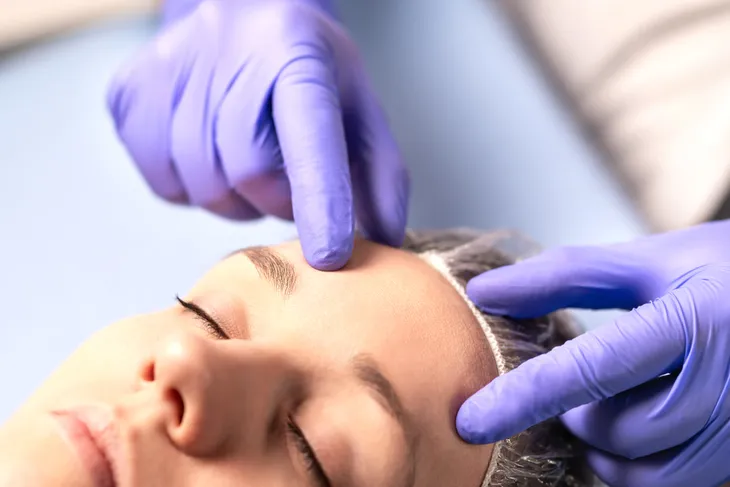Glowing, youthful skin is everyone’s goal but it’s inevitable that our skin loses some of that radiance and bounce as we age. It’s normal to notice a loss in volume, plumpness, and firmness, but there are some procedures available that counteract these effects if you’re interested.
Hyaluronic acid fillers, also known as HA fillers, have increased significantly in popularity in recent years. They achieve instant results in restoring the skin’s youthful appearance by adding volume to sunken under-eyes, lips, cheeks, and more. Curious about HA treatments and what’s involved in the procedure? Follow along as we break down everything you need to know.
What Are Hyaluronic Acid Fillers?
According to dermatologist Dr. Michelle Henry, hyaluronic acid fillers are “a type of temporary dermal fillers designed to reduce the appearance of fine lines and wrinkles.” Unlike other fillers, hyaluronic acid actually exists naturally in the skin and is key to the skin’s plump, hydrated appearance.
Once the HA fillers are injected into the skin, the filler attracts more water, which ultimately leads to the appearance of youthful, plump skin. In fact, hyaluronic acid can hold up to 1,000 times its weight in water.
The Ideal Candidate for HA Fillers
According to the American Society of Plastic Surgeons, the ideal candidate for dermal fillers should have the following:
- Moderate to severe lines or wrinkles
- Good physical health
- Non-smoker
- A positive and realistic expectation of results
- A goal of maintaining healthy skin
Patients with a history of allergic reactions may not be a good fit for this procedure. It’s important to discuss your allergen history with your doctor to ensure HA fillers won’t lead to a reaction.
The Benefits of HA Fillers
The main benefits of HA fillers are that they can decrease wrinkles, add volume and smooth texture of the skin all in one injection. Aside from all those benefits, HA fillers also stimulate collagen production and their benefits can last up to one year.
Henry explains that “HA fillers can stimulate collagen production, which leads to fresher-looking skin, and can be used for preventative reasons, to combat volume loss and fine lines earlier on in the aging process.”
HA Fillers vs. Botox
A common point of confusion with HA fillers is what exactly the difference is between these types of fillers and Botox. The main takeaway to note with this is that hyaluronic acid actually exists naturally in the body, while Botox is a neurotoxin.
Another difference is that Botox and HA fillers address aging concerns in different ways. Botox temporarily “freezes” the underlying muscle so that fine lines and wrinkles cannot continue to form. HA fillers, on the other hand, temporarily fills the area of volume loss and works to plump fine lines until they are not visible.
How to Prepare for HA Fillers
Patients that have an appointment booked to receive HA fillers should avoid alcohol and blood thinners for approximately a week prior to treatment to ensure that unwanted bruising does not occur.
Patients should also fully discuss results and the process with their provider to ensure they are going into their appointment fully educated and with realistic expectations of how they will look following the appointment.
What to Expect During an HA Filler Treatment
Hyaluronic filler treatments are injected through a needle or cannula. The physical sensation is typically quite minimal since most fillers are pre-mixed with lidocaine, which causes the area to become numb during the treatment.
Patients can expect the appointment to take anywhere from 15 to 30-minutes depending on how much filler is being used and where the filler is being injected.
Aftercare
There isn’t any drastic aftercare required with HA fillers, but there are a few things to keep in mind. It’s recommended to avoid alcohol for at least 24-hours after treatment since alcohol is known to intensify bruising. It’s also recommended to avoid aspirin and ibuprofen for at least three days since these can also worsen bruising.
To speed healing, it’s recommended to ensure you’re staying hydrated by drinking lots of water and icing the treated area as needed.
Potential Side Effects
Since hyaluronic acid already exists in the body, there is minimal risk involved with receiving HA fillers. However, there is still a risk of swelling, bruising, and redness which are common side effects with most types of filler.
“A wonderful element to HA fillers is that they can be adjusted,” Henry exclaims. “A dermatologist can inject additional filler or can dissolve it altogether. In case you don’t love your results, HA fillers are easy to tweak.”
How Much Do HA Fillers Cost?
Hyaluronic acid fillers range significantly in price depending on where you’re getting the fillers and how much filler you plan to get injected. According to Dr. Phillip R. Langsdon, one syringe of HA filler often starts at $750 USD.
“Costs can go up or down depending upon the type of hyaluronic acid filler, manufacturer, area of the nation one lives in, area of the face treated, and the number of syringes needed to restore the area being treated,” he continued to explain.
Results
Patients that have received HA fillers can expect the results to last anywhere from 6 to 12-months. According to Healthline, there have been some new developments with HA fillers that can allow them to last 12-months+ in some cases.
In terms of the results, patients can expect a renewed youthful appearance as the HA fillers cater to areas of volume loss in a natural way. HA fillers can also be used for preventative reasons to combat fine lines early on in the aging process.













